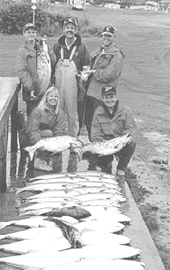Sharing the salmon
 the fixed salmon catch quotas that existed under the original Pacific Salmon Treaty between the United States and Canada are now history. A new agreement based on abundance of the valuable food fish was concluded on June 3, 1999, resolving a long-standing dispute between the neighbouring nations.
the fixed salmon catch quotas that existed under the original Pacific Salmon Treaty between the United States and Canada are now history. A new agreement based on abundance of the valuable food fish was concluded on June 3, 1999, resolving a long-standing dispute between the neighbouring nations.
The new agreement has been submitted to the us and Canadian governments for formal approval. If approved, it ushers in a new age of cooperation between the two countries on the management of salmon. In a joint statement issued today, secretary of State Madeleine Albright and Canadian Foreign Minister Lloyd Axworthy said, "The agreement represents a victory for all those on both sides of the border interested in salmon conservation and the long term viability of our salmon industries.'
The us negotiating team, led by us negotiator Jim Pipkin in coordination with senior White House representative Lloyd Cutler, included representatives of the governors of Alaska, Washington, and Oregon and 24 Indian tribes. The agreement establishes abundance-based fishing regimes for the major salmon intercepting fisheries in the us and Canada. These regimes, which allow catches in fisheries to vary from year to year, are designed to implement the conservation and harvest sharing principles of the Pacific Salmon Treaty.
Larger catches will be allowed when abundance is higher and, importantly, catches will be constrained in years when abundance is down. This type of regime will be more responsive to the conservation requirements of salmon than the fixed ceilings that existed under the original Treaty arrangements. The agreement brings stability to the management of salmon fisheries and provides a firm and complementary base for other salmon recovery efforts, such as habitat restoration, underway in both countries.
If the agreement wins formal approval, the Pacific Salmon Treaty Endowment Funds will be created. Two funds, one in the North and one for the South totalling us $140 million, will be administered jointly by both countries and funded by the us government. The funds will invest in habitat, stock enhancement, science and salmon management initiatives in both countries. Subject to the availability of appropriated funds, the us will contribute us $75 million and us $65 million dollars to a northern and a southern fund, respectively, over a four-year period.
For the Fraser River sockeye run, the us share will be 16.5 per cent, the officials said. This compares with last year's agreed share of 24.9 per cent and a historical average of 20.5 per cent between 1985 and 1996. "For sockeye, pink and chum fisheries, where stocks are in relatively good health, the new arrangements will restrict us interceptions, or increase Canadian catch,' Anderson said. For weak stocks, such as South Coast Coho salmon, Northern Boundary Coho, and Chinook salmon coastwide, the new arrangements will provide additional protection for Canadian stocks in us fisheries. For the first time, Alaska agreed to closures at low levels of abundance that will protect Canadian Coho.
The two countries have agreed to concentrate on maintaining adequate water quality and quantity, the achievement of improved spawning success and migration corridors for adult and juvenile salmon, and other measures that maintain and increase the production of natural stocks. The Pacific Salmon Commission will be directed to report annually to the parties to identify stocks for which measures beyond harvest controls are required. The commission must report on the non-fishing factors that limit production, options for addressing these factors and progress of the parties in implementing measures to improve production.
